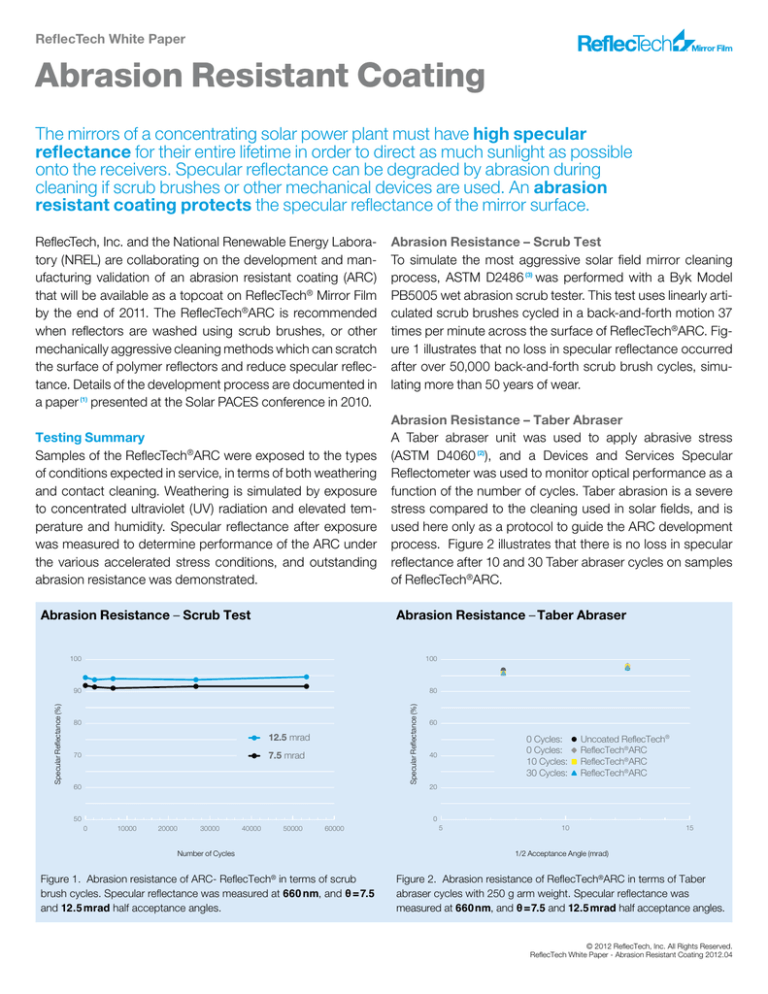
ReflecTech White Paper
Abrasion Resistant Coating
The mirrors of a concentrating solar power plant must have high specular
reflectance for their entire lifetime in order to direct as much sunlight as possible
onto the receivers. Specular reflectance can be degraded by abrasion during
cleaning if scrub brushes or other mechanical devices are used. An abrasion
resistant coating protects the specular reflectance of the mirror surface.
ReflecTech, Inc. and the National Renewable Energy Laboratory (NREL) are collaborating on the development and manufacturing validation of an abrasion resistant coating (ARC)
that will be available as a topcoat on ReflecTech® Mirror Film
by the end of 2011. The ReflecTech®ARC is recommended
when reflectors are washed using scrub brushes, or other
mechanically aggressive cleaning methods which can scratch
the surface of polymer reflectors and reduce specular reflectance. Details of the development process are documented in
a paper (1) presented at the Solar PACES conference in 2010.
Testing Summary
Samples of the ReflecTech®ARC were exposed to the types
of conditions expected in service, in terms of both weathering
and contact cleaning. Weathering is simulated by exposure
to concentrated ultraviolet (UV) radiation and elevated temperature and humidity. Specular reflectance after exposure
was measured to determine performance of the ARC under
the various accelerated stress conditions, and outstanding
abrasion resistance was demonstrated.
Abrasion Resistance – Taber Abraser
A Taber abraser unit was used to apply abrasive stress
(ASTM D4060 (2)), and a Devices and Services Specular
Reflectometer was used to monitor optical performance as a
function of the number of cycles. Taber abrasion is a severe
stress compared to the cleaning used in solar fields, and is
used here only as a protocol to guide the ARC development
process. Figure 2 illustrates that there is no loss in specular
reflectance after 10 and 30 Taber abraser cycles on samples
of ReflecTech®ARC.
Abrasion Resistance – Taber Abraser
100
100
90
80
Specular Reflectance (%)
Specular Reflectance (%)
Abrasion Resistance – Scrub Test
Abrasion Resistance – Scrub Test
To simulate the most aggressive solar field mirror cleaning
process, ASTM D2486 (3) was performed with a Byk Model
PB5005 wet abrasion scrub tester. This test uses linearly arti­
culated scrub brushes cycled in a back-and-forth motion 37
times per minute across the surface of ReflecTech®ARC. Figure 1 illustrates that no loss in specular reflectance occurred
after over 50,000 back-and-forth scrub brush cycles, simulating more than 50 years of wear.
80
12.5 mrad
7.5 mrad
70
60
60
0 Cycles:
0 Cycles:
10 Cycles:
30 Cycles:
40
Uncoated ReflecTech®
ReflecTech®ARC
ReflecTech®ARC
ReflecTech®ARC
20
0
50
0
10000
20000
30000
40000
50000
60000
5
10
15
Number of Cycles
1/2 Acceptance Angle (mrad)
Figure 1. Abrasion resistance of ARC- ReflecTech® in terms of scrub
brush cycles. Specular reflectance was measured at 660 nm, and θ = 7.5
and 12.5 mrad half acceptance angles.
Figure 2. Abrasion resistance of ReflecTech®ARC in terms of Taber
abraser cycles with 250 g arm weight. Specular reflectance was
measured at 660 nm, and θ = 7.5 and 12.5 mrad half acceptance angles.
© 2012 ReflecTech, Inc. All Rights Reserved.
ReflecTech White Paper - Abrasion Resistant Coating 2012.04
UV Resistance - UAWS
Hemispherical Reflectance (%)
100
0
5
10
15
20
25
30
80
Resistance to Moisture
Samples of ReflecTech®ARC laminated to aluminum panels
were immersed in deionized water for 30 days. There was no
sign of delamination at any layer interface. The cross hatch
tape peel test was also performed after immersion, and there
was no loss of adhesion.
60
Equivalent Years of Exposure
0.0
4.9
10.3
40
20
0
200
200
1000
1400
1800
2200
2600
Wavelength (nm)
Figure 3. Spectral hemispherical reflectance of ReflecTech®ARC
samples after 0 (initial), 4.9, and 10.3 years’ equivalent UV exposure
in NREL’s UAWS. Samples exposed at 30°C.
UV Resistance
Figure 3 illustrates the outstanding UV resistance of the
ReflecTech®ARC material. After the equivalent of over 10
years UV exposure in NREL’s Ultra Accelerated Weathering
System (UAWS, described in (4)) there is no significant spectral loss in hemispherical reflectance.
For more information, please contact:
Info@ReflecTechSolar.com
ReflecTech, Inc.
18200 West Highway 72
Arvada, CO 80007, USA
www.ReflecTechSolar.com
Adhesion
Adhesion of the ARC to the ReflecTech® Mirror Film was measured before and after weathering using ASTM D3359 crosshatch tape peel test (5) – there was no loss of adhesion.
Conclusions
The ReflecTech®ARC has demonstrated excellent abrasion
resistance, adhesion, and weatherability. Resistance to Taber
abrasion is maintained after exposure to UV light, condensation cycling, and thermal cycling. Commercial introduction of
ReflecTech®ARC is anticipated toward the end of 2011.
References:
(1) Gary Jorgensen, Randy Gee, and Michael DiGrazia, “Development and
Testing of Abrasion Resistant Hard Coats for Polymer Film Reflectors”, Solar
PACES, 2010.
(2) ASTM D4060, “Standard Test Method for Abrasion Resistance of Organic Coatings by the Taber Abraser”, American Society of Testing and Materials Annual
Book of Standards, Vol. 06.01, ASTM International, West Conshohocken, PA,
www.astm.org.
(3) ASTM D2486, “Standard Test Methods for Scrub Resistance of Wall Paints”,
American Society of Testing and Materials Annual Book of Standards, Vol. 06.02,
ASTM International, West Conshohocken, PA, www.astm.org.
(4) H. K. Hardcastle, G. J. Jorgensen, and C. E. Bingham, “Ultra-Accelerated
Weathering System I: Design and Functional Considerations”, Natural and Artificial
Ageing of Polymers – 4th European Weathering Symposium; Reichert, T., Ed.
Publication No. 11, Gesellschaft fur Umweltsimulation: Germany, 2009.
(5) ASTM D3359, “Standard Test Methods for Measuring Adhesion by Tape Test”,
American Society of Testing and Materials Annual Book of Standards, Vol. 06.01,
ASTM International, West Conshohocken, PA, www.astm.org.


